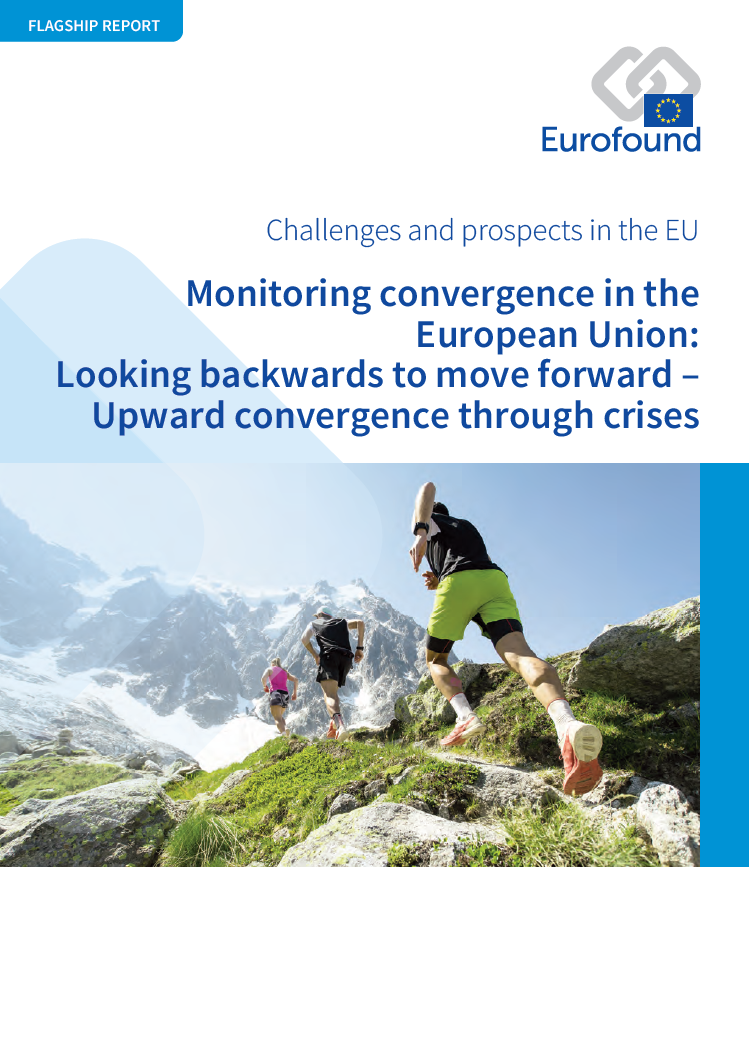
Pozytywna konwergencja jest podstawą projektu europejskiego. Państwa członkowskie i ich obywatele wstępują do Unii, ponieważ oczekują, że członkostwo w niej przyniesie zrównoważony dobrobyt gospodarczy i postęp społeczny we wszystkich krajach. Rosnące nierówności między państwami członkowskimi, jak to miało miejsce podczas kryzysu gospodarczego w latach 2008-2013, mogą być postrzegane jako zdrada obietnicy UE i potencjalnie mogą stać się źródłem niezadowolenia i dezintegracji. Ten raport przewodni jest zwieńczeniem badań Eurofound nad monitorowaniem konwergencji w UE, które rozpoczęto w 2017 r. Opisuje on zmieniającą się dynamikę pozytywnej konwergencji w okresie 2008–2019, bada krótkoterminowy wpływ pandemii COVID-19 na gospodarki i społeczeństwa europejskie i implikacje dotyczące konwergencji, a także omawia długoterminowe skutki pandemii i przyszłość pozytywnej konwergencji gospodarczej i społecznej w Europie.
Key findings
Kryzys gospodarczy (lata 2008–2013) wywarł w państwach członkowskich UE istotny negatywny wpływ na pozytywną konwergencję. Chociaż konwergencja gospodarcza została szybko przywrócona, rozbieżności w dziedzinie zatrudnienia i warunków życia utrzymywały się do 2013 r., co pokazuje, jak ściśle konwergencja społeczna i gospodarcza są ze sobą powiązane.
Podczas gdy wiele wskaźników społecznych zaczęło wykazywać pozytywną konwergencję w okresie odbudowy w latach 2014-2019, kryzys gospodarczy pozostawił po sobie nierównomierną spuściznę w sensie geograficznym. O ile Europa Środkowa i Wschodnia nadal zdecydowanie zbliżała się do prosperującego regionu północno-zachodniego, o tyle Europa Południowa coraz bardziej pozostawała w tyle zarówno pod względem społecznym, jak i gospodarczym.
W latach 2008–2019 w większości państw członkowskich UE nie wystąpiła pozytywna konwergencja w zakresie jakości sprawowania rządów i instytucji. W kontekście pandemii COVID-19 konwergencja dotycząca jakości instytucjonalnej będzie ważnym sposobem przełożenia konwergencji gospodarczej na trwałą konwergencję społeczną w Europie Wschodniej oraz poprawy obu tych zjawisk w Europie Południowej.
Zdecydowane działania polityczne na szczeblu UE i krajowym podjęte w odpowiedzi na pandemię zapobiegły bardziej niszczycielskiemu i nierównomiernemu wpływowi kryzysu na rynki pracy i warunki życia w UE. Ponieważ jednak kryzys pandemiczny nie został jeszcze w pełni zażegnany, kluczowe znaczenie będzie miała kontynuacja tych wysiłków politycznych, zwłaszcza w kontekście transformacji cyfrowej i ekologicznej, gdzie właściwe narzędzia polityczne będą miały zasadnicze znaczenie dla zapobiegania nowym rozbieżnościom między północnym wschodem a południowym zachodem.
Kluczowe znaczenie będzie miało pełne wdrożenie planów Europejskiego Instrumentu na rzecz Odbudowy (NextGenerationEU), a konwergencja między państwami członkowskimi UE będzie zależała od stopnia dostosowania krajowych planów odbudowy do wizji na szczeblu unijnym. Gotowość rządów do skupienia się na priorytetach ponadnarodowych jest szansą na odwrócenie nierówności wywołanych pandemią COVID-19, a szczególnie istotna będzie koordynacja na poziomie UE.
The flagship report contains the following list of tables and figures.
List of tables
Table 1: Overview of indicators
Table 2: Drivers of employment in the EU (panel analysis)
Table 3: Drivers of employment growth in the EU (panel analysis)
Table 4: Summary of economic convergence trends in sigma, delta and beta convergence and at the regional level
Table 5: Summary of social convergence trends in sigma, delta and beta convergence and at the regional level
Table 6: Summary of institutional convergence trends in sigma, delta and beta convergence
Table A1: Drivers of employment in the EU (panel analysis)
Table A2: Drivers of employment growth in the EU (panel analysis)
Table A3: Impact of unemployment changes on GDP per capita (regression coefficients), EU27, 2000–2019
List of figures
Figure 1: The three dimensions of convergence
Figure 2: Sigma and delta convergence in GDP per capita (PPS), EU27, 2008–2019
Figure 3: Unconditional beta convergence in GDP per capita (PPS), EU27, 2008–2019
Figure 4: Regional quintile clusters of GDP per capita in PPS in 2008 and 2019 and cluster mobility from 2008 to 2019, EU NUTS 2
Figure 5: Sigma and delta convergence in disposable household income per capita (PPS), 2008–2019
Figure 6: Unconditional beta convergence in disposable household income per capita (PPS), 2008–2019
Figure 7: Regional quintile clusters of disposable household income per capita in PPS in 2008 and 2019 and cluster mobility from 2008 to 2019, EU NUTS 2
Figure 8: Sigma and delta convergence in income inequality (income quintile share ratio), EU27, 2008–2019
Figure 9: Unconditional beta convergence in income inequality (income quintile share ratio), EU27, 2008–2019
Figure 10: Sigma and delta convergence in monthly minimum wage (PPS), 2008–2019
Figure 11: Unconditional beta convergence in monthly minimum wage (PPS), 2008–2019
Figure 12: Sigma and delta convergence in the employment rate (%), EU27, 2008–2019
Figure 13: Unconditional beta convergence in the employment rate (%), EU27, 2008–2013 and 2013–2019
Figure 14: Regional quintile clusters of the employment rate in 2008 and 2019 and cluster mobility from 2008 to 2019, EU NUTS 2
Figure 15: Sigma and delta convergence in the unemployment rate (%), EU27, 2008–2019
Figure 16: Unconditional beta convergence in the unemployment rate (%), EU27, 2008–2013 and 2013–2019
Figure 17: Regional quintile clusters of the unemployment rate in 2008 and 2019 and cluster mobility from 2008 to 2019, EU NUTS 2
Figure 18: Sigma and delta convergence in the gender employment gap (%), EU27, 2008–2019
Figure 19: Unconditional beta convergence in the gender employment gap (%), EU27, 2008–2019
Figure 20: Regional quintile clusters of the gender employment gap in 2008 and 2019 and cluster mobility from 2008 to 2019, EU NUTS 2
Figure 21: Sigma and delta convergence in the youth NEET rate (%), EU27, 2008–2019
Figure 22: Unconditional beta convergence in the youth NEET rate (%), EU27, 2008–2013 and 2013–2019
Figure 23: Regional quintile clusters of the youth NEET rate in 2008 and 2019 and cluster mobility from 2008 to 2019, EU NUTS 2
Figure 24: Sigma and delta convergence in the early school leavers rate (%), EU27, 2008–2019
Figure 25: Unconditional beta convergence in the early school leavers rate (%), EU27, 2008–2019
Figure 26: Regional quintile clusters of the early school leavers rate in 2008 and 2019 and cluster mobility from 2008 to 2019, EU NUTS 2
Figure 27: Sigma and delta convergence in the AROPE rate (%), EU27, 2008–2019
Figure 28: Unconditional beta convergence in the AROPE rate (%), EU27, 2008–2013 and 2013–2019
Figure 29: Sigma and delta convergence in unmet medical needs (%), EU27, 2008–2019
Figure 30: Unconditional beta convergence in unmet medical needs (%), EU27, 2008–2019
Figure 31: Sigma and delta convergence in the WGI rule of law, EU27, 2008–2019
Figure 32: Unconditional beta convergence in the WGI rule of law, EU27, 2008–2019
Figure 33: Sigma and delta convergence in the WGI government effectiveness, EU27, 2008–2019
Figure 34: Unconditional beta convergence in the WGI government effectiveness, EU27, 2008–2019
Figure 35: Sigma and delta convergence in the WGI regulatory quality, EU27, 2008–2019
Figure 36: Unconditional beta convergence in the WGI regulatory quality, EU27, 2008–2019
Figure 37: Sigma and delta convergence in the WGI voice and accountability, EU27, 2008–2019
Figure 38: Unconditional beta convergence in the WGI voice and accountability, EU27, 2008–2019
Figure 39: Sigma and delta convergence in the WGI control of corruption, EU27, 2008–2019
Figure 40: Unconditional beta convergence in the WGI control of corruption, EU27, 2008–2019
Figure 41: Sigma and delta convergence in the Ease of Doing Business score, EU27, 2010–2019
Figure 42: Unconditional beta convergence in the Ease of Doing Business score, EU27, 2010–2019
Figure 43: Regional clusters of the European Quality of Government Index score (EQI), EU NUTS 1 and 2, 2010 and 2017
Figure 44: Employment rates in the previous year and annual growth rates by EU Member State, 2000–2019
Figure 45: Employment growth in southern and central and eastern countries relative to western/northern Europe (regression coefficients plot)
Figure 46: Summary of the regional leaders and laggards in the social dimension and cluster mobility in the economic dimension, EU NUTS 2, 2008–2019
Figure 47: Relationship between GDP and unemployment in 2008–2009 (growth rates), EU27
Figure 48: Relationship between GDP and unemployment in 2019–2020 (growth rates), EU27
Figure 49: Actual versus predicted unemployment rate in 2020 (%), EU27
Figure 50: SURE loans and the unemployment gap in 2020, EU27
Figure 51: Unweighted average employment rate and projections to meet the European Pillar of Social Rights Action Plan 2030 target (%), EU27
Figure 52: Unweighted average youth NEET rate and projections to meet the European Pillar of Social Rights Action Plan 2030 target (%), EU27
Figure 53: Sigma convergence in GDP per capita (PPS), EU27, 2013–2020
Figure 54: Change in GDP per capita (in PPS) by Member State (%), EU27, 2019–2020
Figure 55: Unconditional beta convergence in GDP per capita (PPS), EU27, 2019–2020
Figure 56: Percentage change in GDP per capita (in PPS), EU27, 2019–2020
Figure 57: Sigma convergence in the unemployment rate (%), EU27, 2013–2021 (monthly data: January 2020–May 2021)
Figure 58: Change in unemployment rate by Member State (percentage points), EU27, 2019–2020
Figure 59: Unconditional beta convergence of the unemployment rate (%), EU27, 2019–2020
Figure 60: Percentage point change in the unemployment rate, EU NUTS 2, 2019–2020
Figure 61: Sigma convergence in the activity rate (%), EU27, 2013–2020 (quarterly data: Q4 2019–Q4 2020)
Figure 62: Sigma convergence in labour market slack (%), EU27, 2013–2020 (quarterly data: Q4 2019–Q4 2020)
Figure 63: Unconditional beta convergence in labour market slack (%), EU27, 2019–2020
Figure 64: Estimated change in the at-risk-of-poverty rate, EU, 2019–2020
Figure 65: Sigma convergence in the youth NEET rate (%), EU27, 2013–2020 (quarterly data: Q4 2019–Q4 2020)
Figure 66: Unconditional beta convergence in the youth NEET rate (%), EU27, 2019–2020
Figure 67: Degree of plausibility (on a scale of 1–10) of the health recovery scenarios as assessed by Eurofound experts
Figure 68: Possible economic recovery scenarios
Figure 69: Expected speed of economic recovery, EU27
Figure 70: Experts’ opinions on the expected economic crisis triggered by the COVID-19 pandemic (on a scale of 0–100)
- Number of pages
-
120
- Reference nº
-
EF21008
- ISBN
-
978-92-897-2237-7
- Catalogue nº
-
TJ-01-21-504-EN-N
- DOI
-
10.2806/78744
- Permalink
Cite this publication
Eurofound (2021), Monitoring convergence in the European Union: Looking backwards to move forward – Upward convergence through crises, Challenges and prospects in the EU series, Publications Office of the European Union, Luxembourg.
